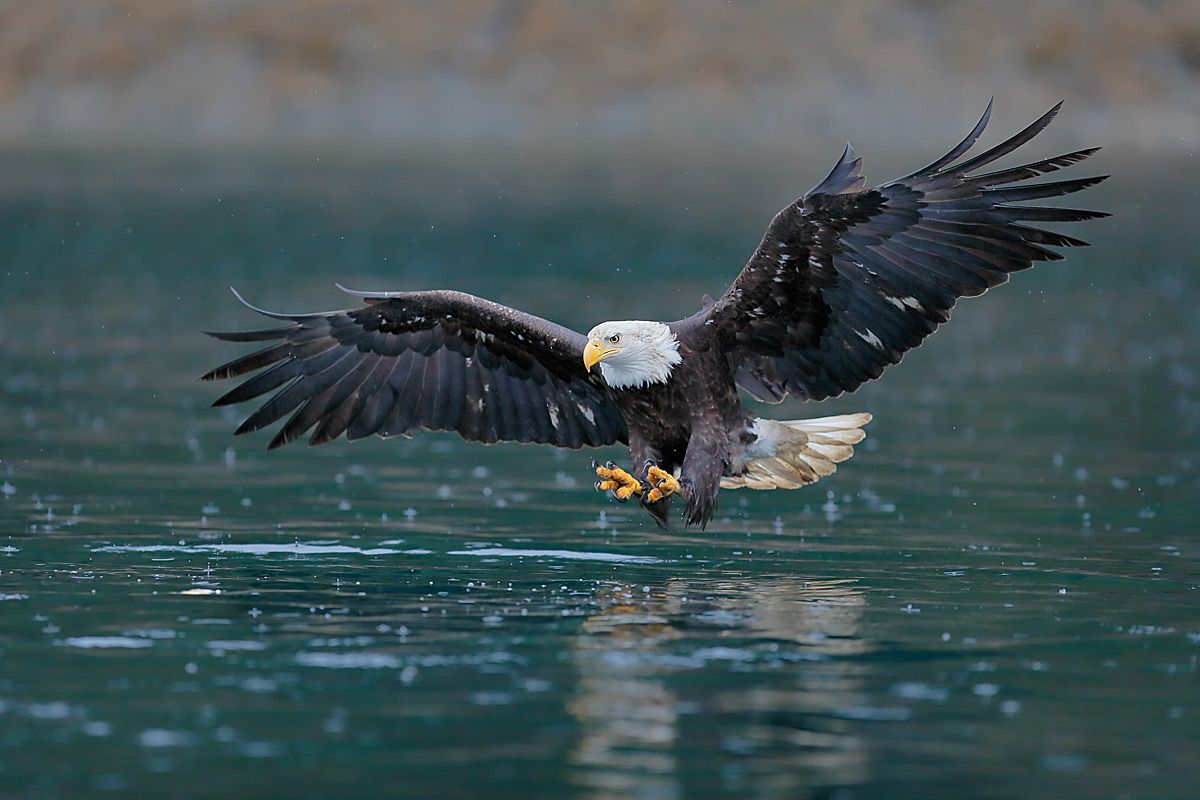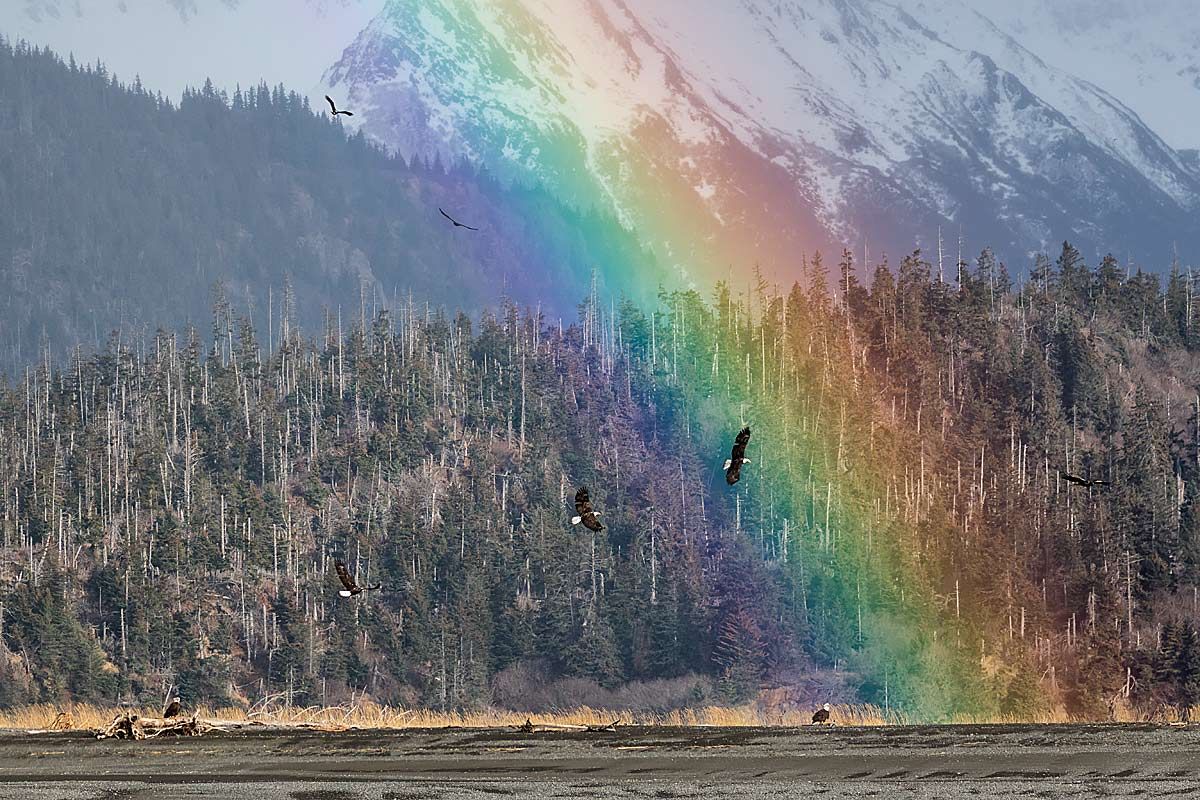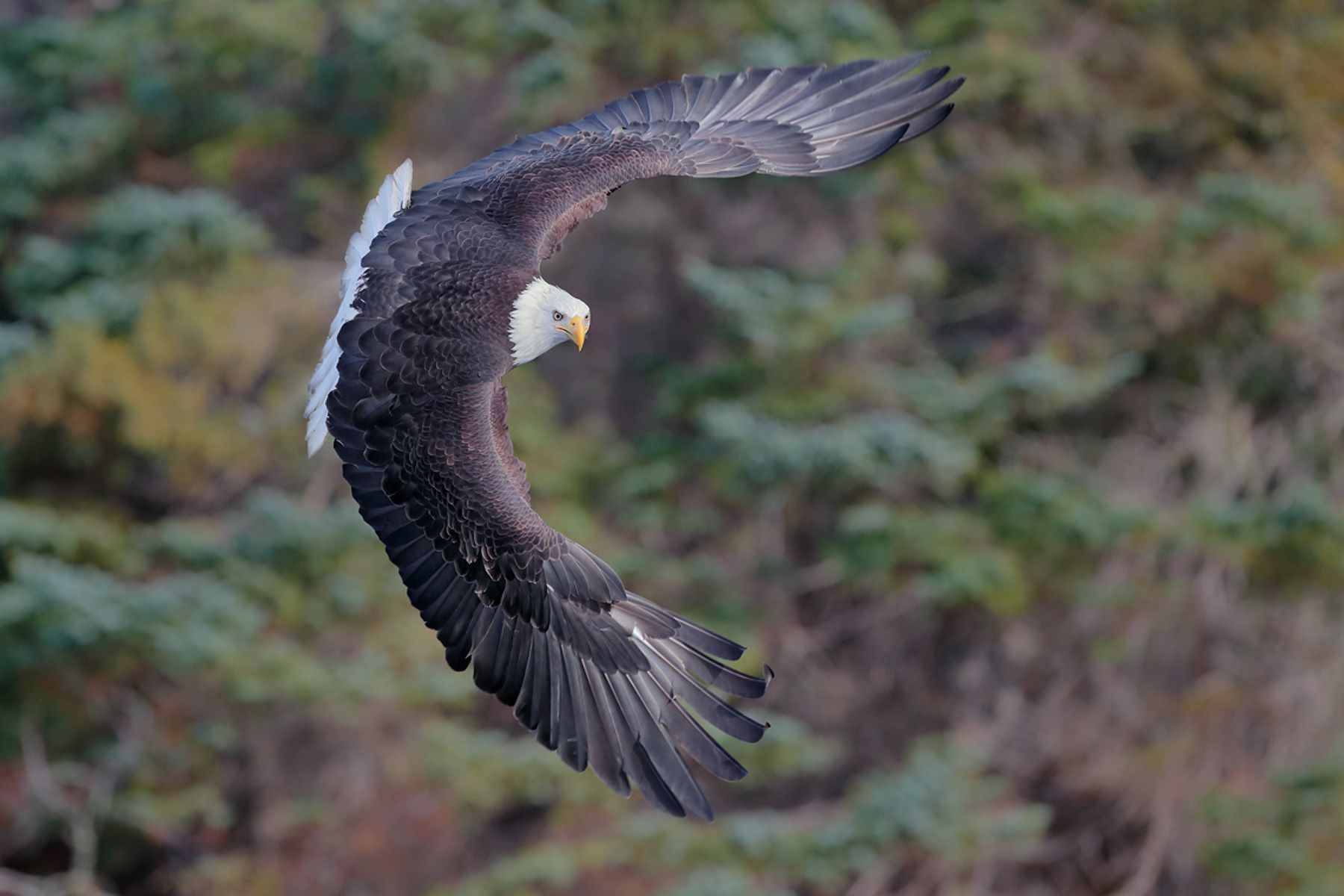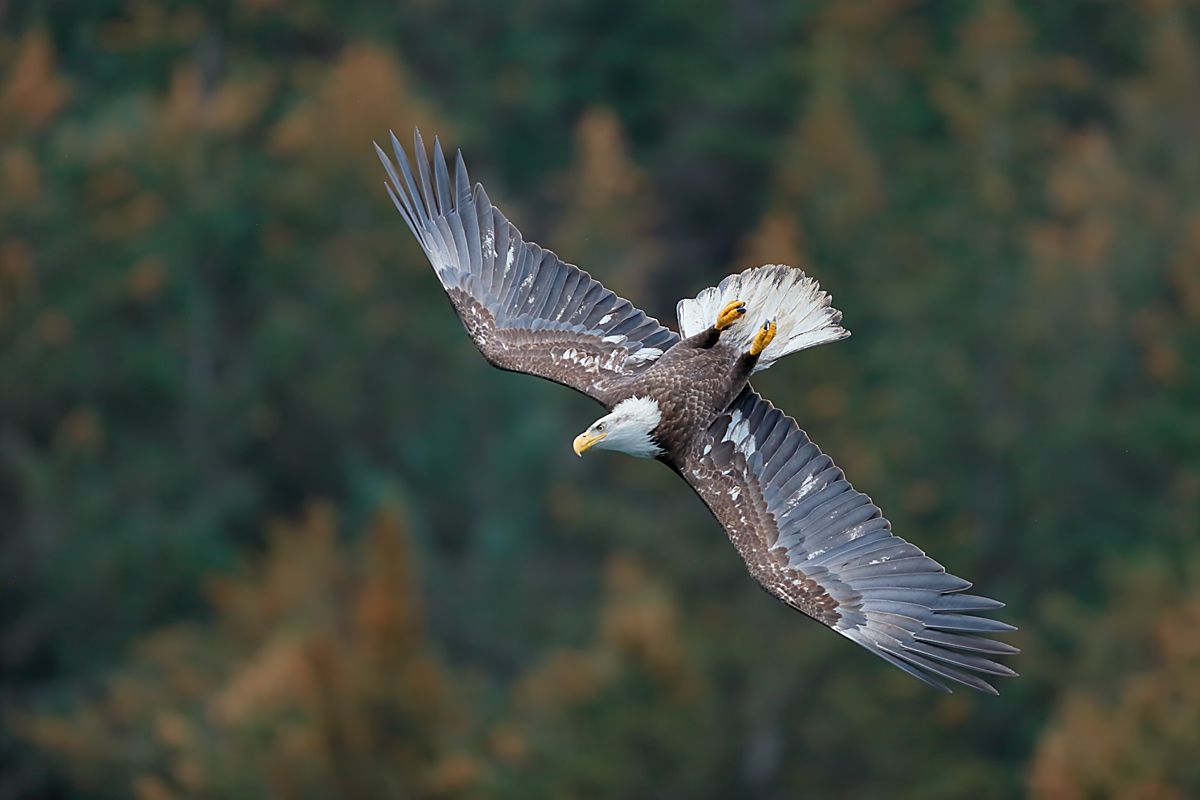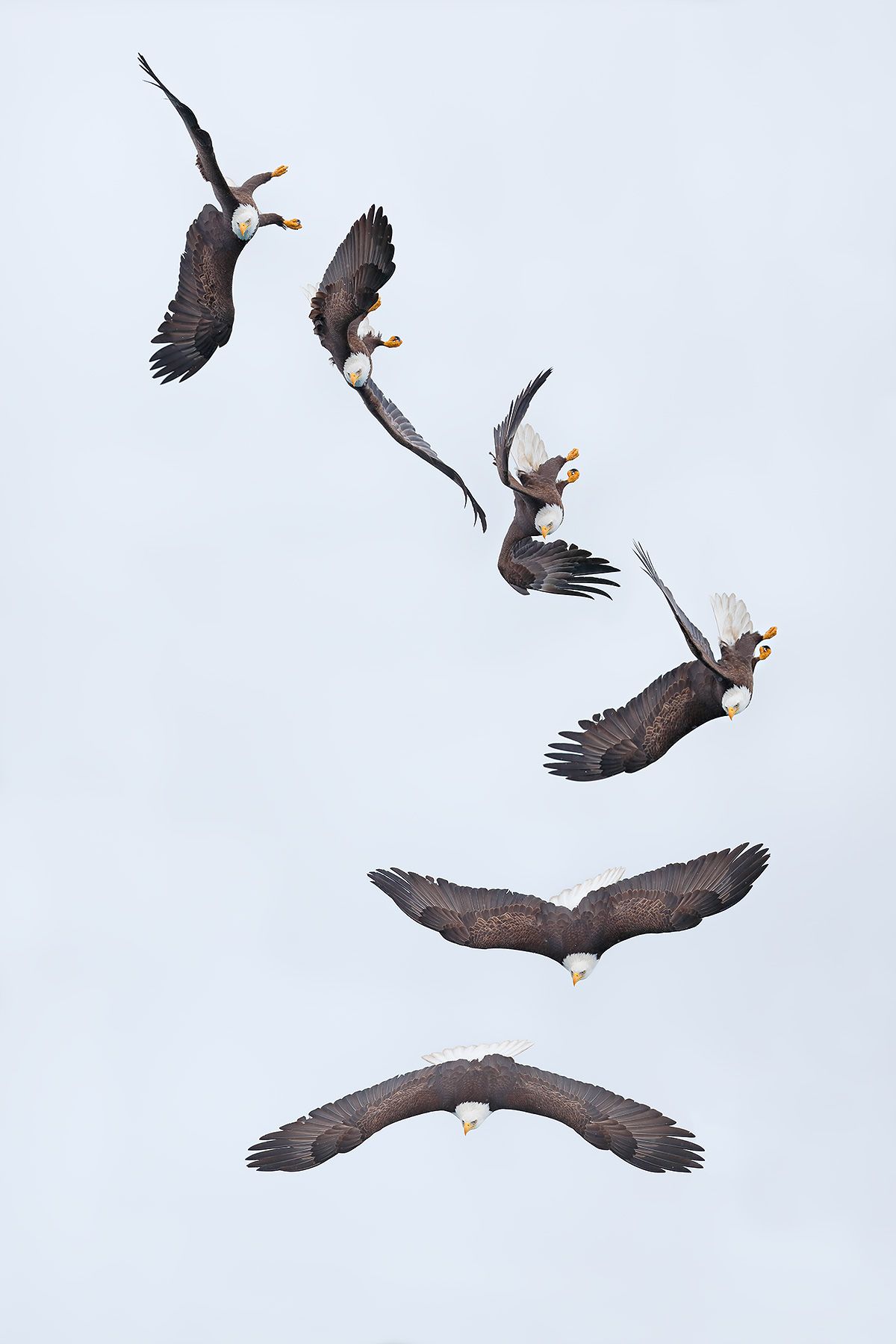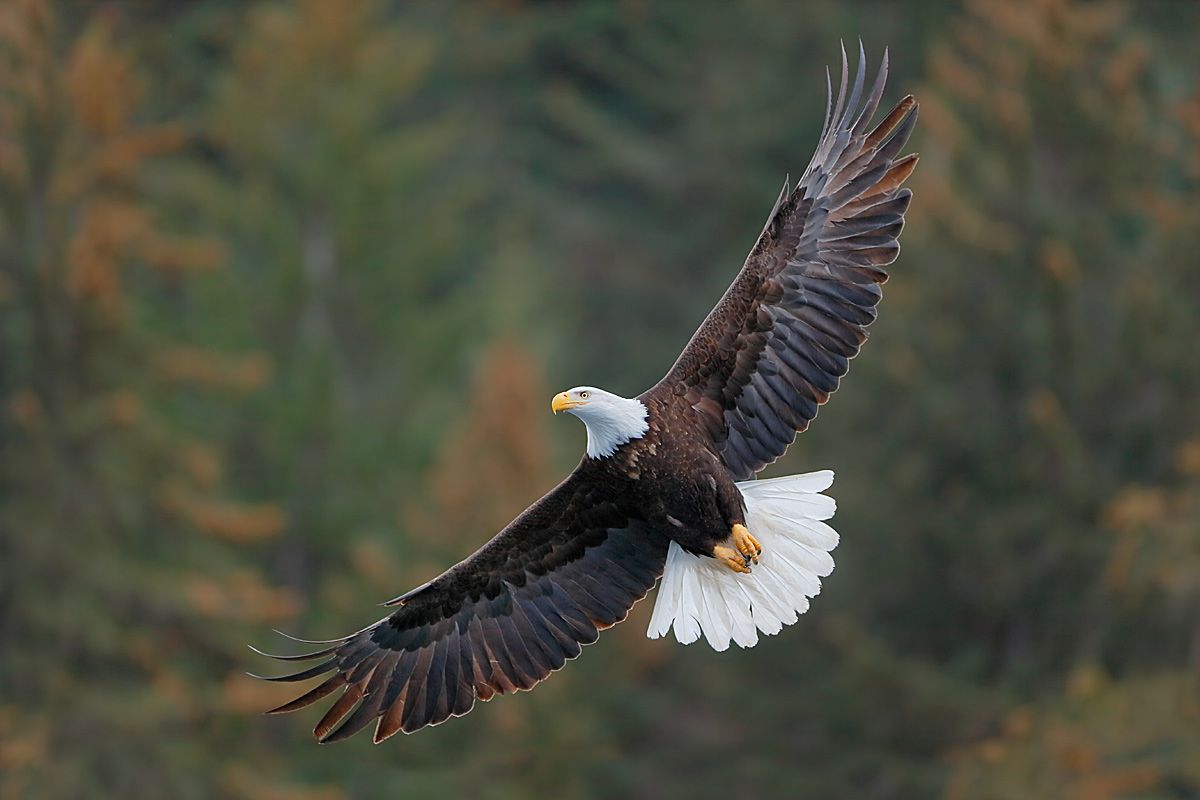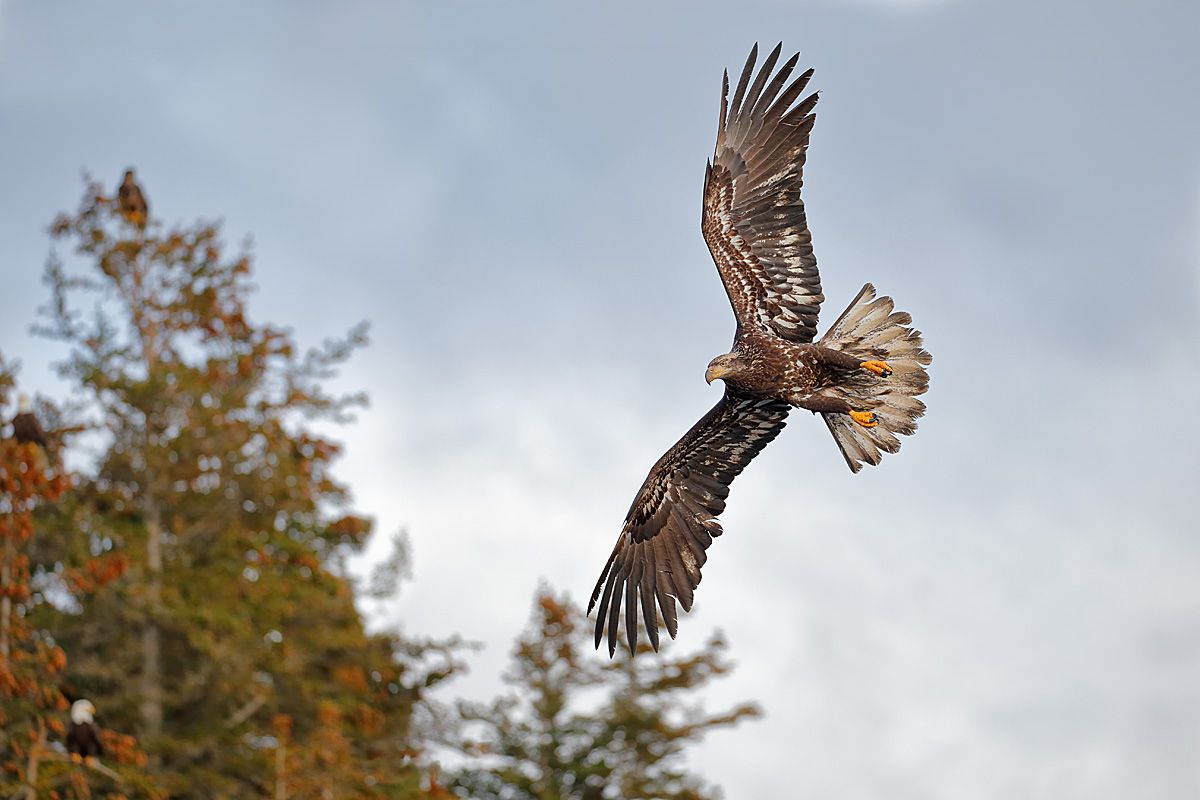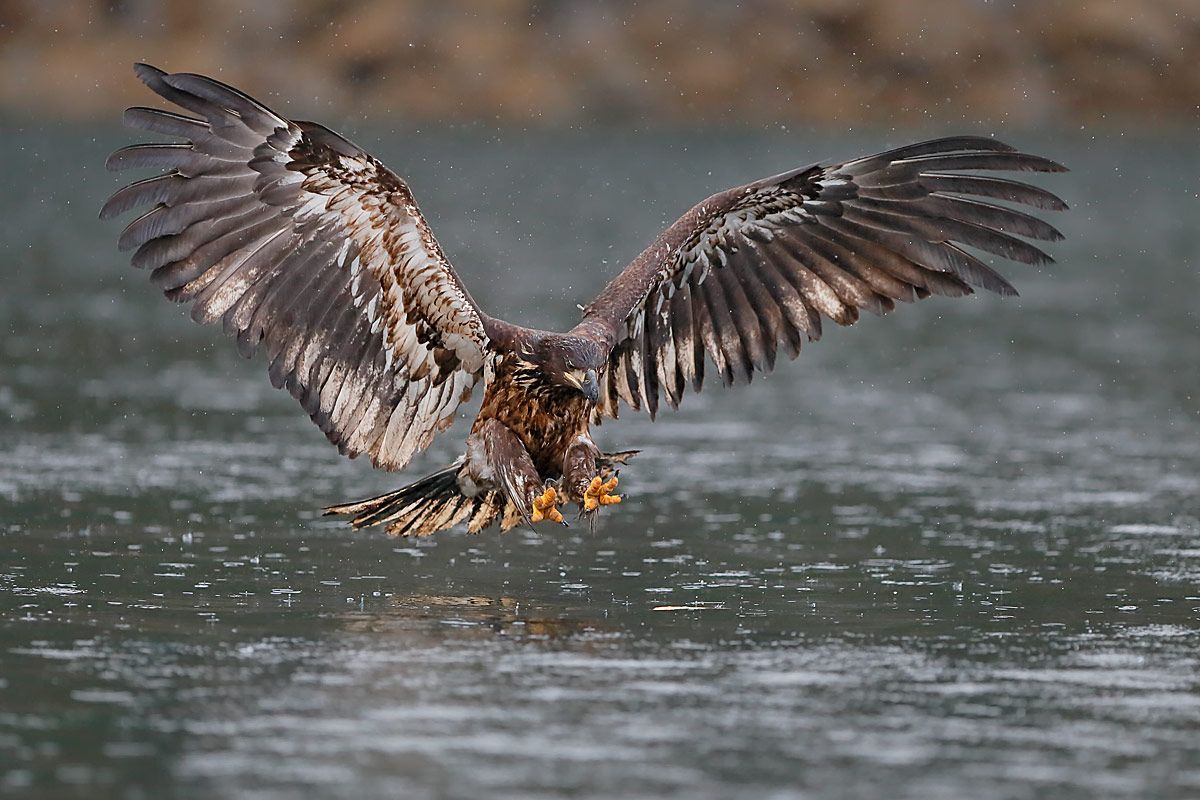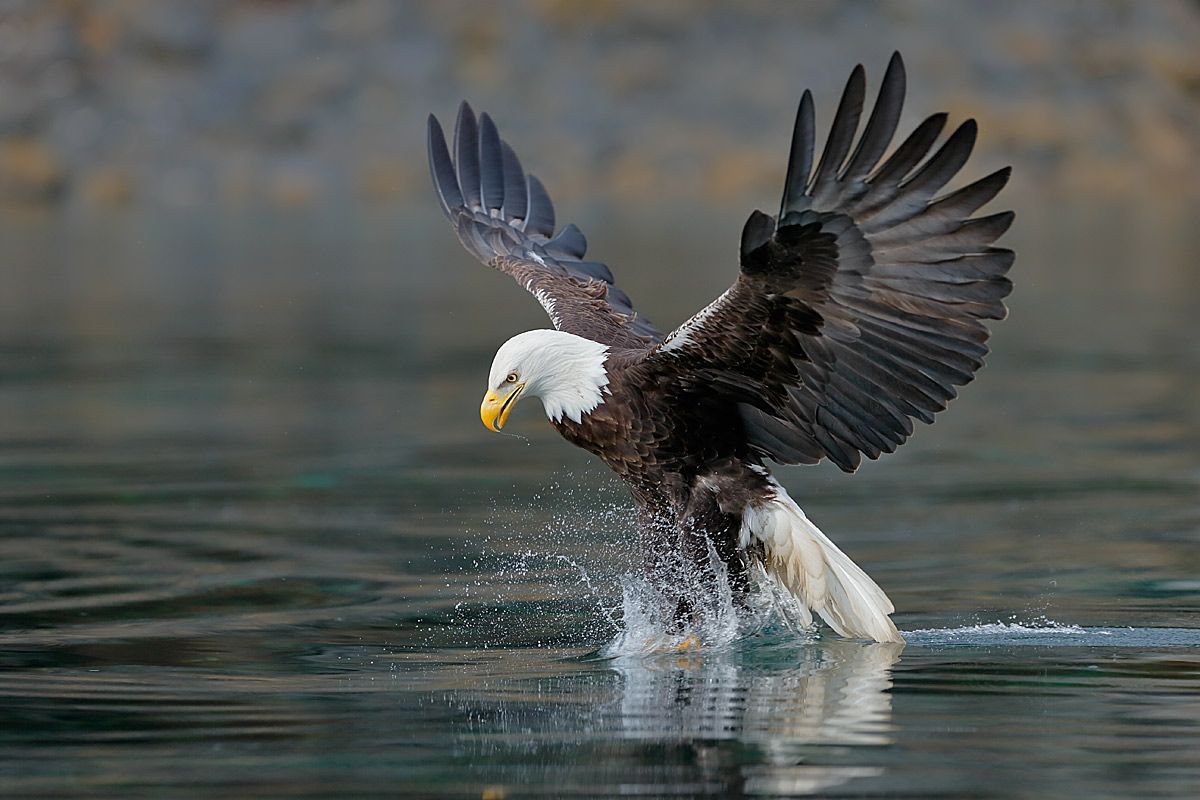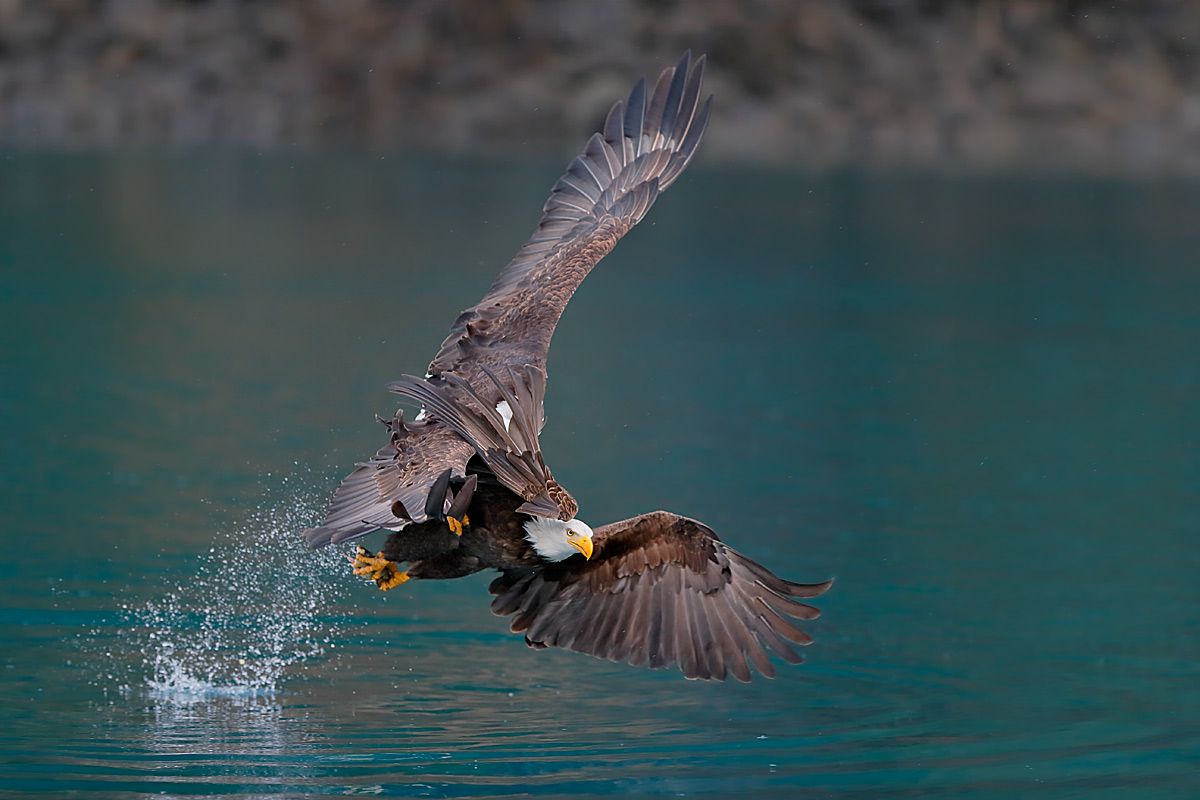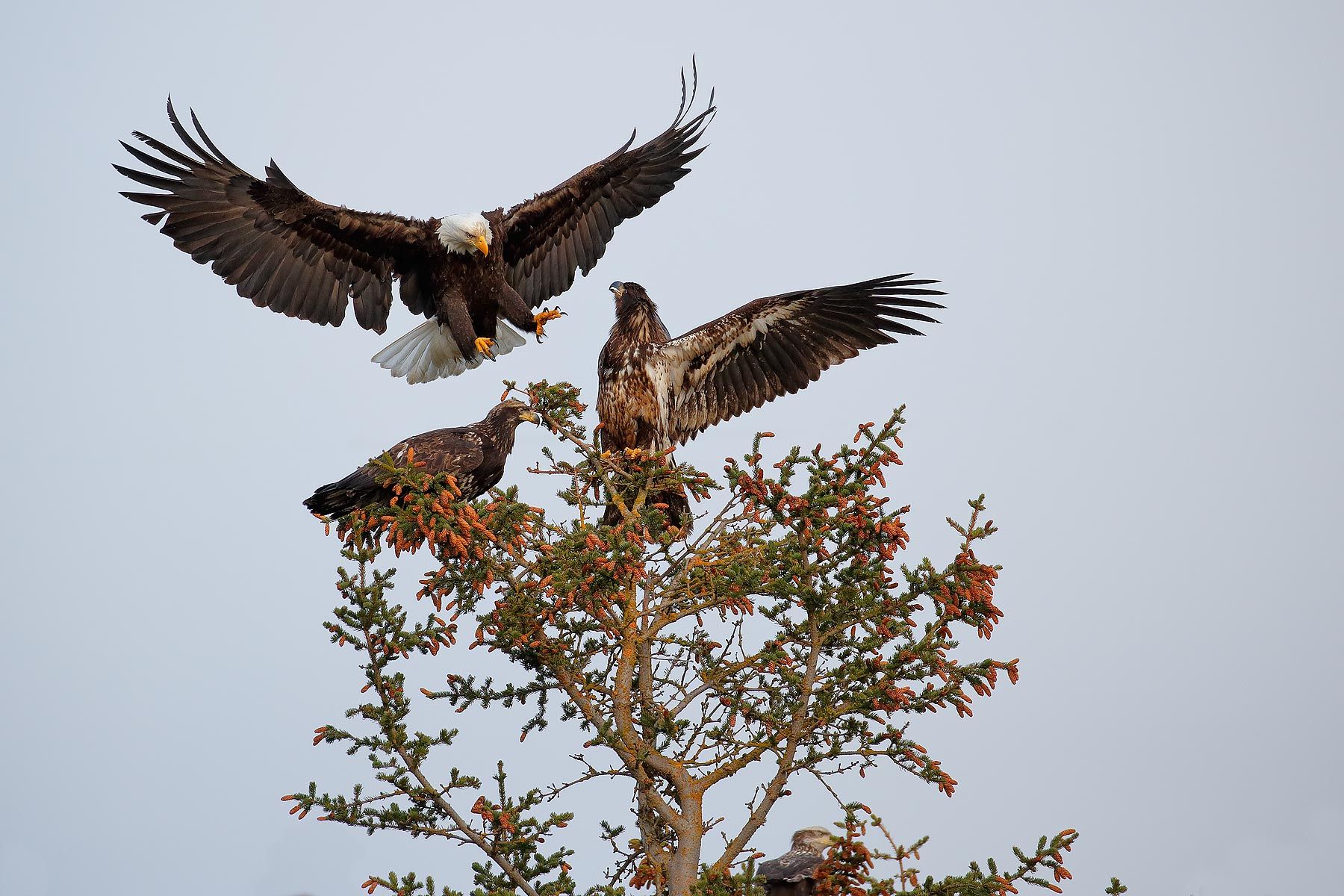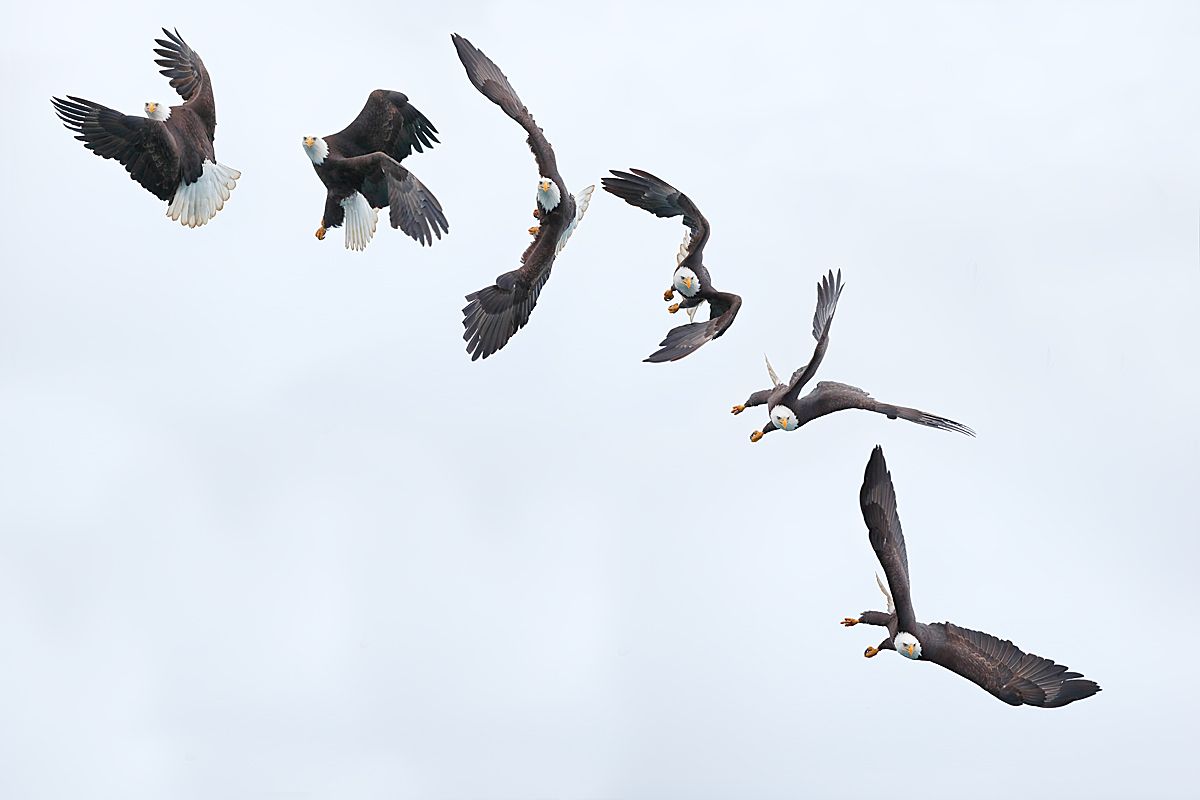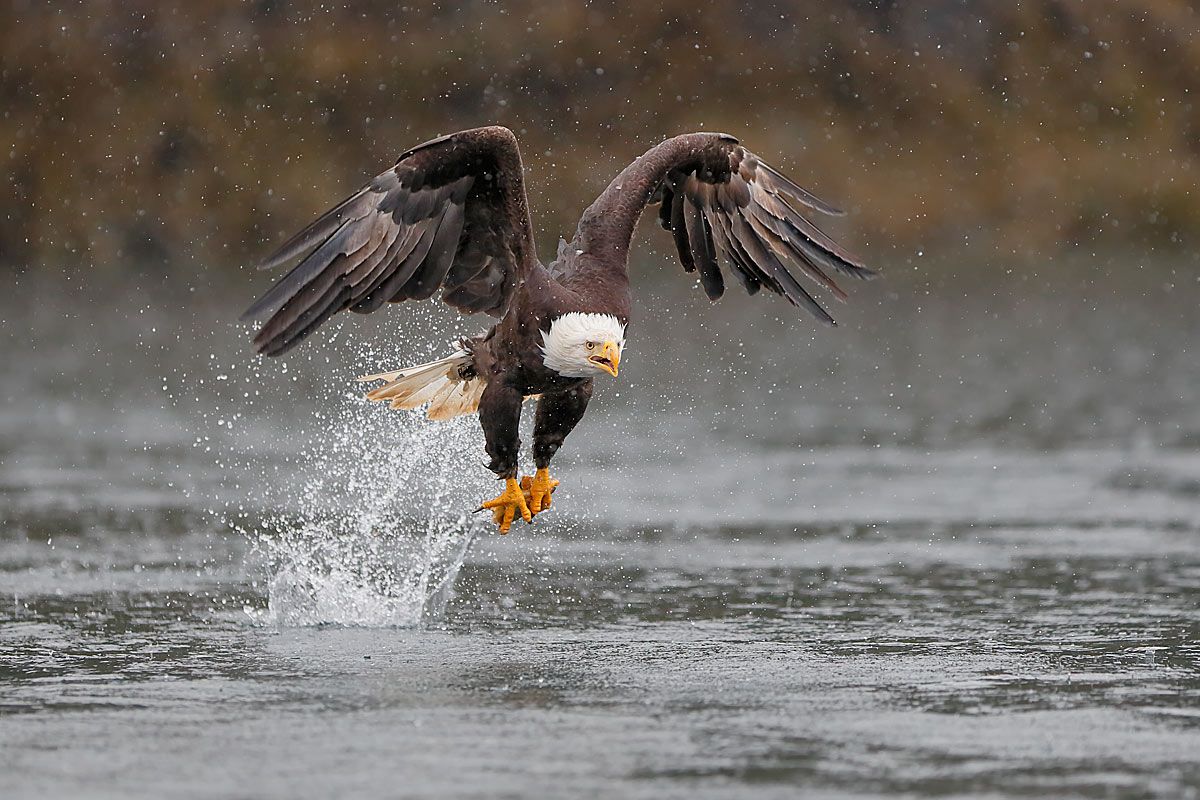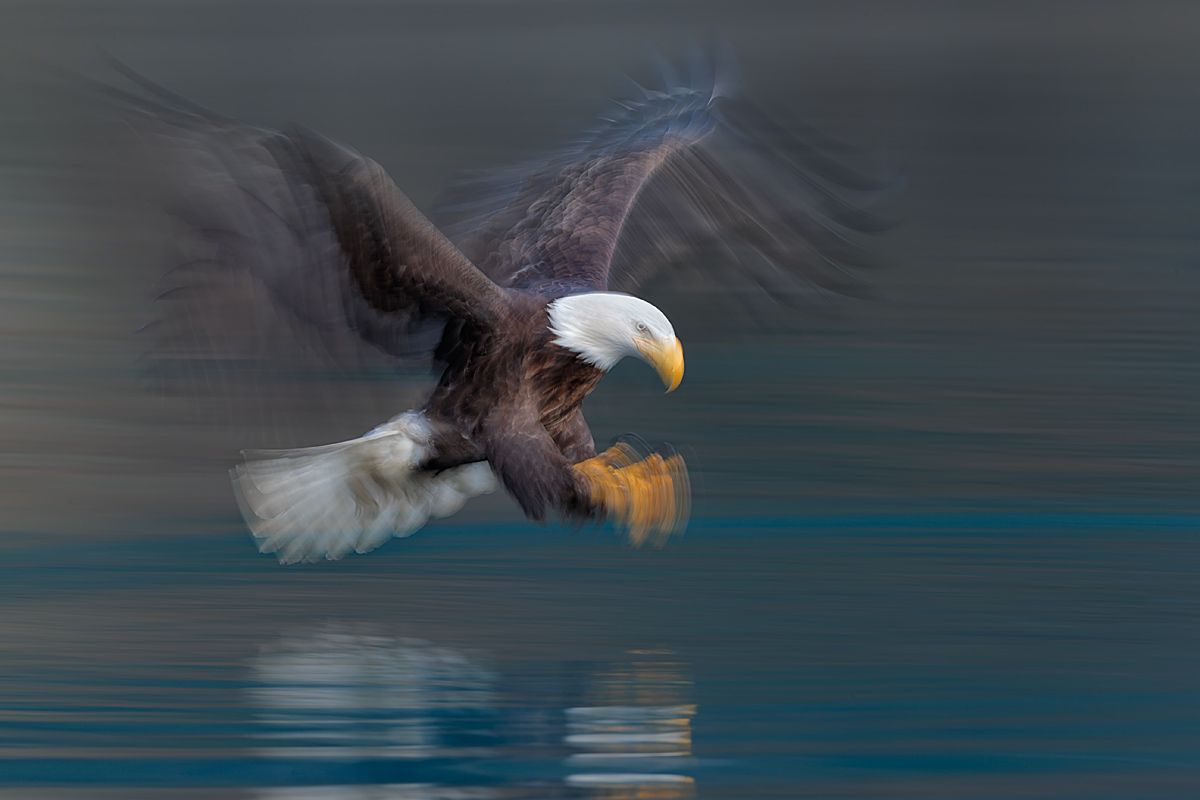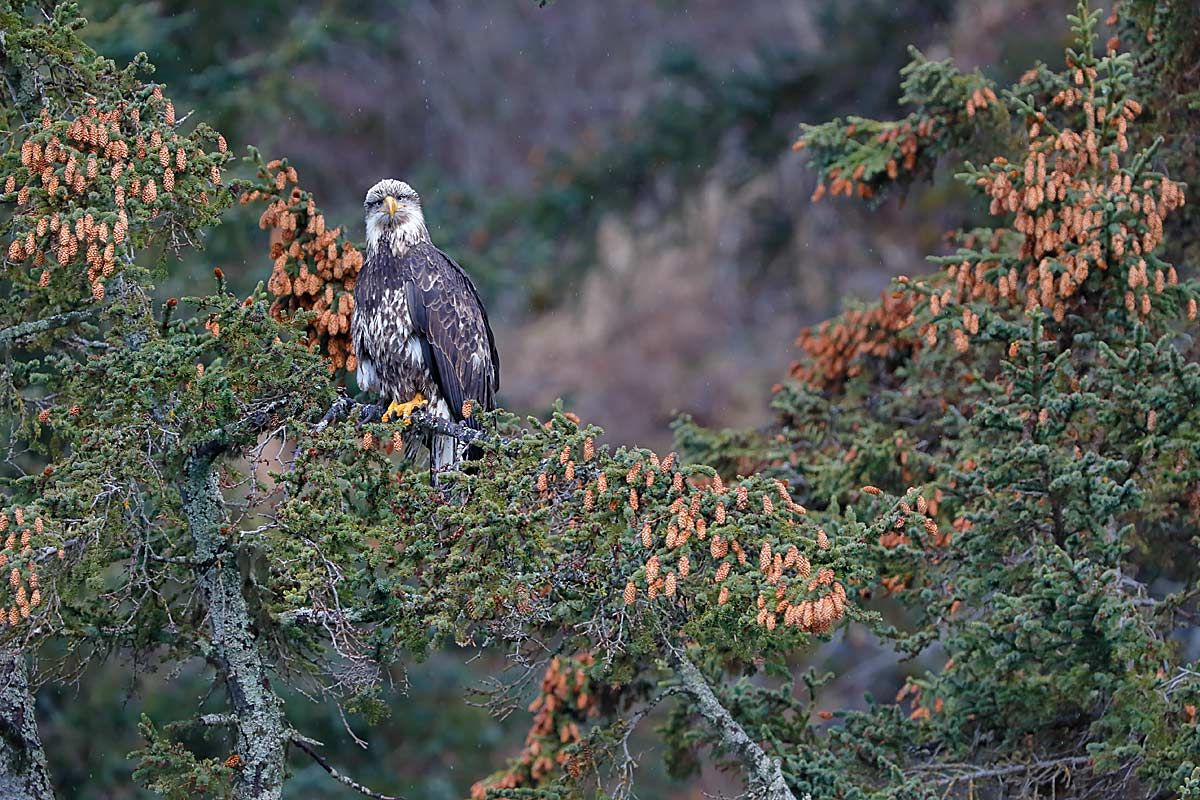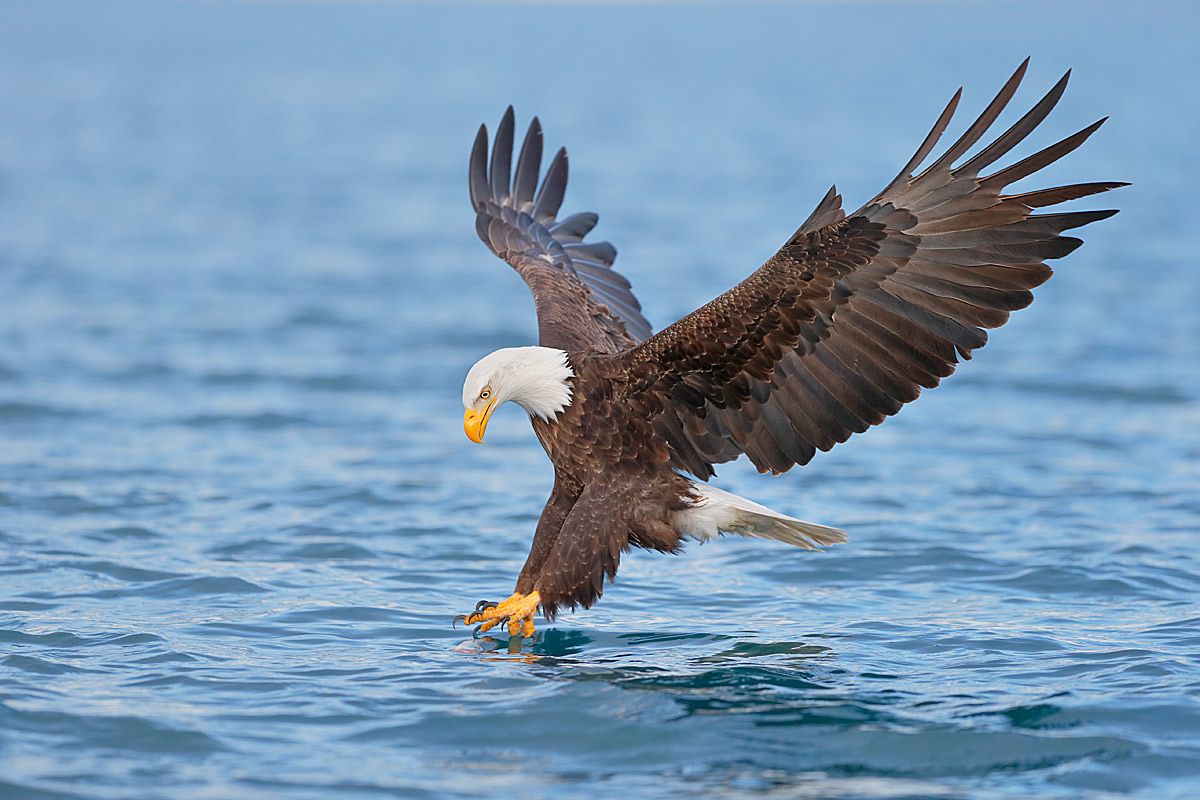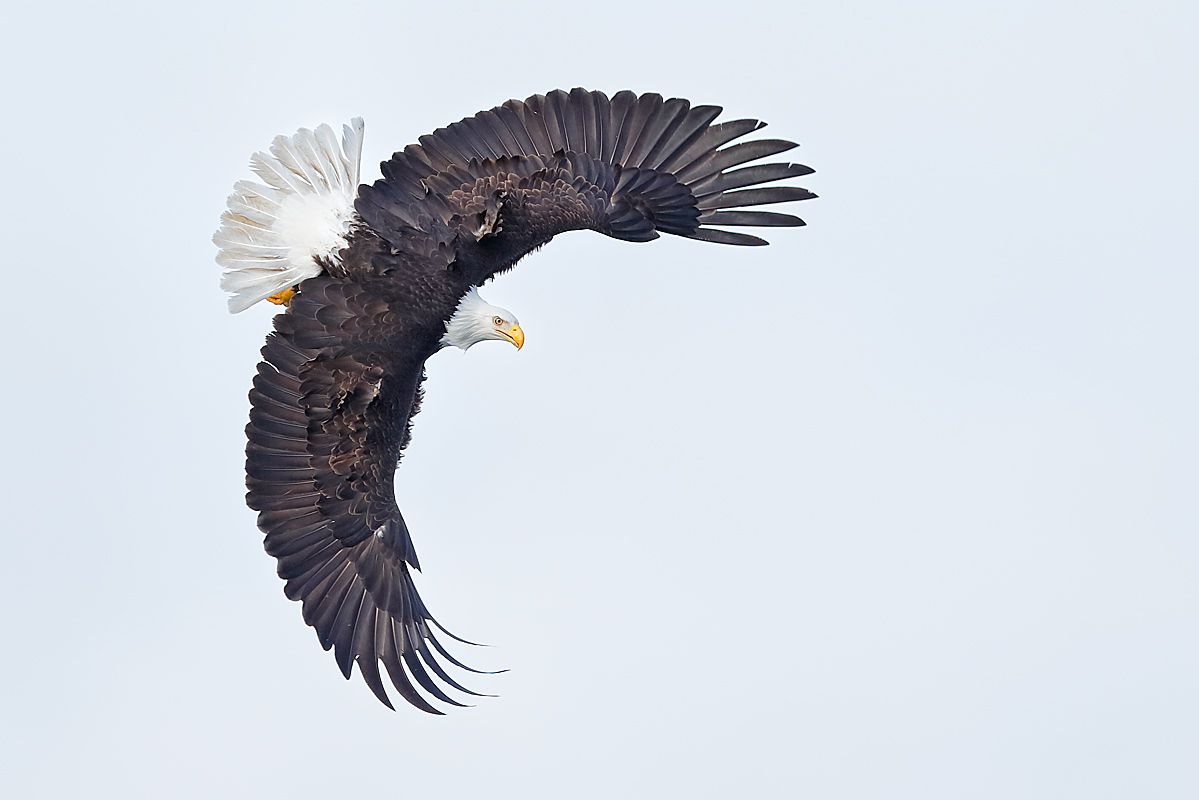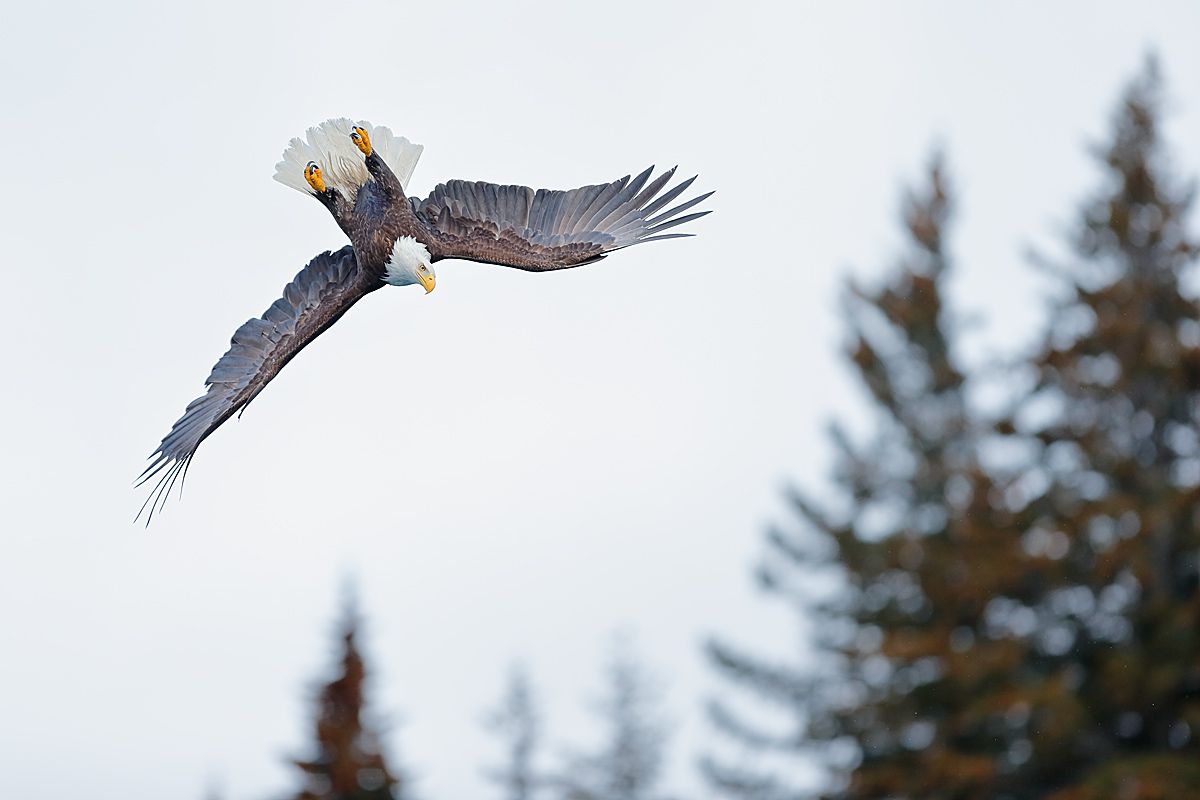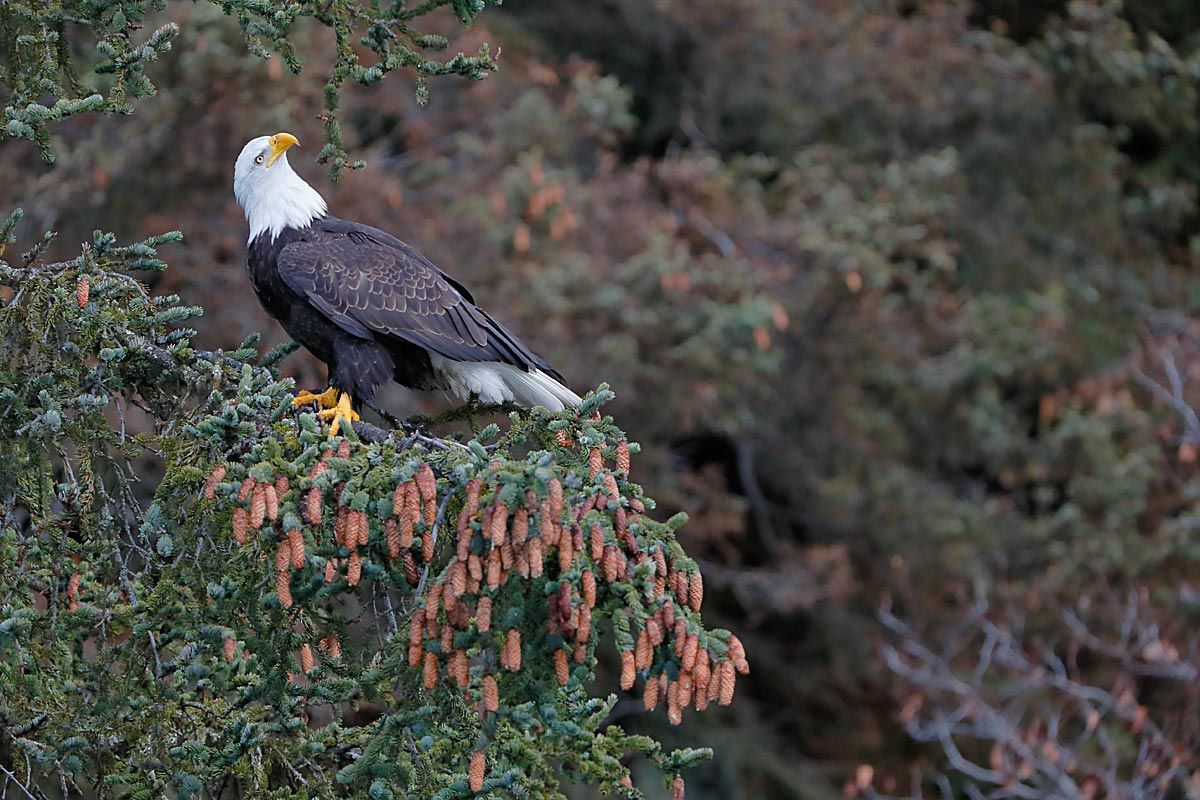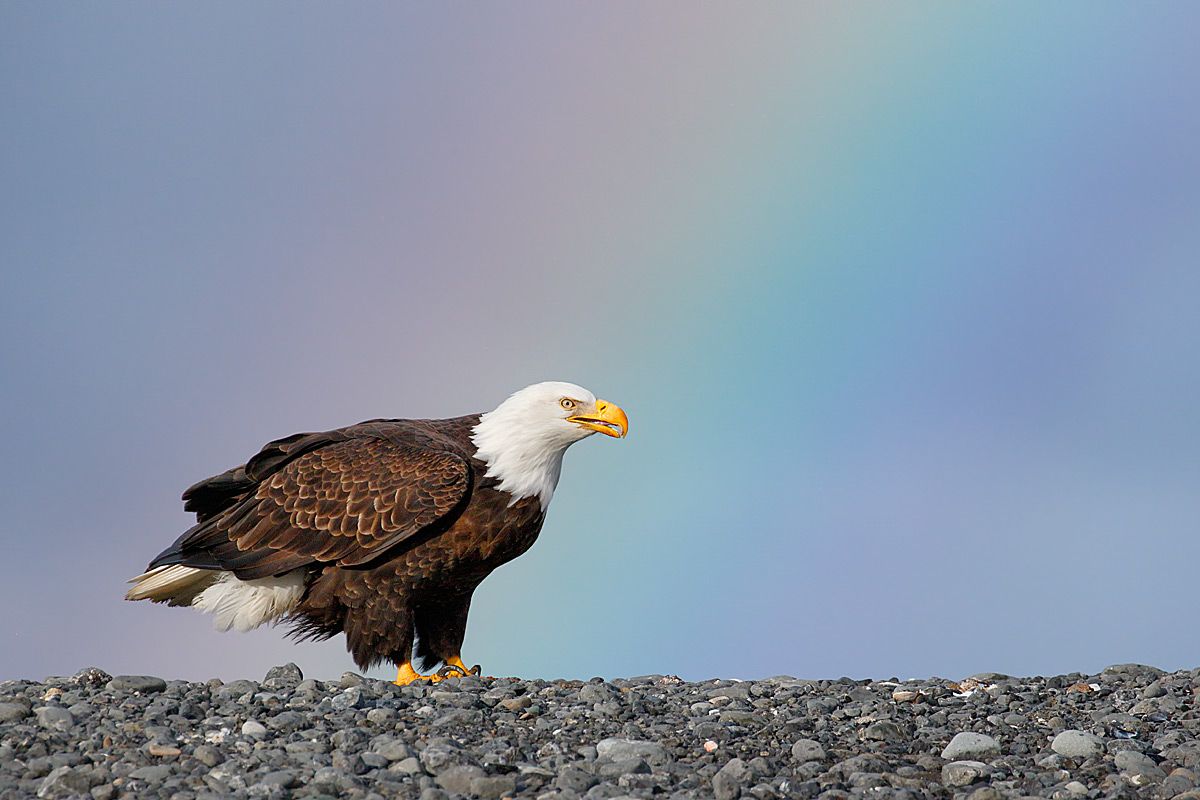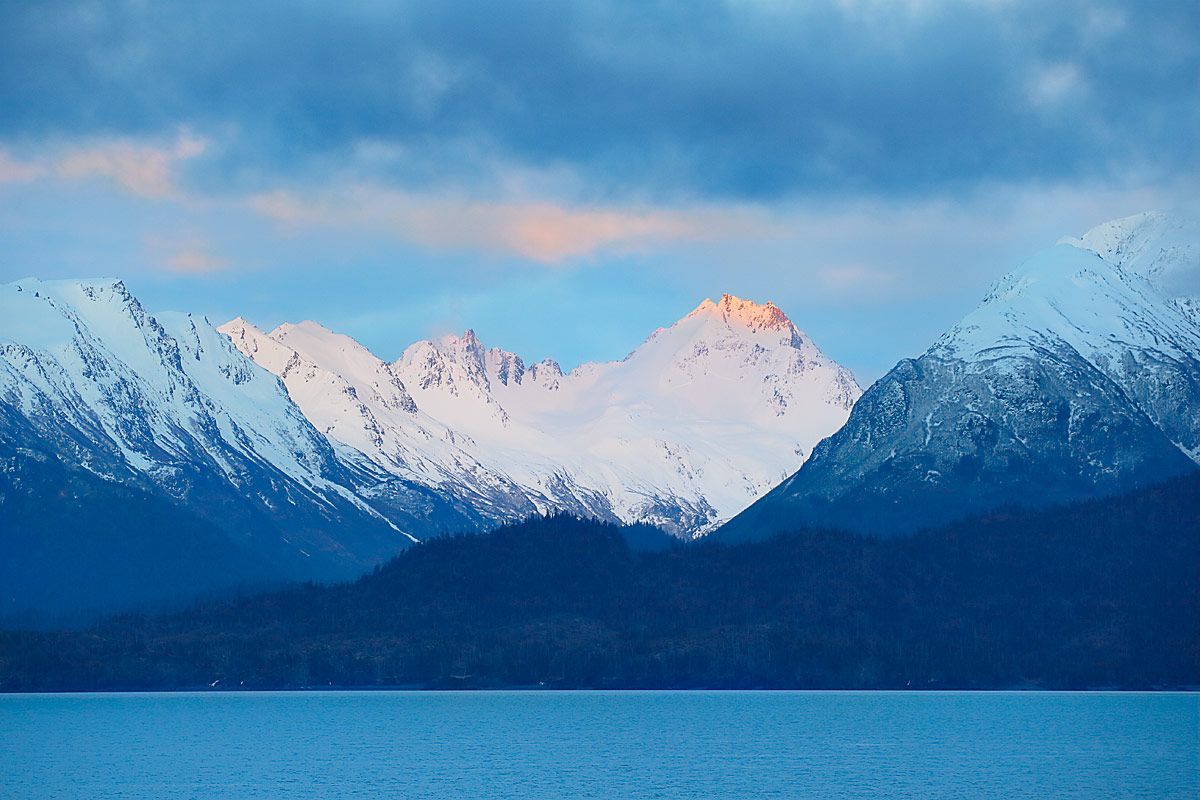I recently spent a week up in Alaska photographing bald eagles. It was my fourth time photographing the eagles in their natural environment around Kachemak Bay on the Kenai Peninsula, and it never gets boring to see these majestic and powerful birds go about their life in the wild. As a photographer, I like to revisit the same subjects and same locations multiple times to allow me to document a wide variety of images under different circumstances and at different times during the year. No matter if it is the Southern Ocean and Antarctica or a specific animal species, if you want to get a good feel for the subject you need to photograph it more than once under changing conditions.
Bald Eagle Fascination

Bald eagle fishing sequence. Canon EOS 1DX, Canon EF 300mm f/2.8L IS USM Lens @ f4, 1/2500s, ISO 640, Manual exposure. Composite of 5 images. Image by Clemens Vanderwerf and copyright 2015.
As I knew what to expect, I was well prepared for the shooting circumstances. The weather can change quickly and you can get wind, snow, and sunshine all within the hour. One thing is for sure and that is that the weather forecast is wrong most of the time. In general the weather was pretty dark and dingy with lots of grey skies during my stay. It was a good choice to bring the Canon EF 300mm/f2.8 IS lens, as I often needed the extra f-stop to keep the shutter speed up for the action.
Bald eagle coming in for the catch. Canon EOS 1DX, Canon EF 300mm f/2.8L IS USM Lens @ f2.8, 1/3200s, ISO 1600, Manual exposure. Image by Clemens Vanderwerf and copyright 2015.
Rainbow with bald eagles flying. Canon EOS 1DX, Canon EF 70-200mm f/2.8L II IS USM Lens @ 188mm, f5, 1/1600s, ISO 640, Manual exposure and polarizer filter. Image by Clemens Vanderwerf and copyright 2015.
A bit of color always helps. Even a rainbow showed itself for a couple of minutes when the sun peaked through the rain clouds. It had been the warmest winter on record in Alaska, and the locals hardly had any snow this winter. A pretty big contrast with 2012, which was recorded as one of the strongest winters in recent years. Due to the warm temperatures the spruce trees were loaded with beautiful cones earlier than usual, which provided some scenic backgrounds.
Bald eagle banking against the spruce trees. Canon EOS 1DX, Canon EF 300mm f/2.8L IS USM Lens @ f4, 1/2000s, ISO 1000, Manual exposure. Image by Clemens Vanderwerf and copyright 2015.
Immature bald eagle upside down. Canon EOS 1DX, Canon EF 300mm f/2.8L IS USM Lens @ f2.8, 1/2000s, ISO 1250, Manual exposure. Image by Clemens Vanderwerf and copyright 2015.
The one thing that fascinates me about bald eagles is not only their powerful and majestic appearance but especially their flying skills. They are true masters of the sky and are able to perform some stunning aerobatics. With a very keen eyesight they spot their prey from miles away and are able to target with precision, just like a modern day fighter jet. Typically, the eagles sit up high in the spruce trees overlooking the water until they spot a fish. In matter of seconds the eagle launches forward into a dive towards the water, keeping his eyes locked on the fish, and with one big swoop of the talons flies off again with the catch.
Bald eagle banking turn sequence. Canon EOS 1DX, Canon EF 300mm f/2.8L IS USM Lens @ f3.2, 1/2500s, ISO 1250, Manual exposure. Composite of 6 images. Image by Clemens Vanderwerf and copyright 2015.
Bald eagle flying passed the spruce trees. Canon EOS 1DX, Canon EF 300mm f/2.8L IS USM Lens @ f2.8, 1/2000s, ISO 1000, Manual exposure. Image by Clemens Vanderwerf and copyright 2015.
Immature bald eagle flying over head. Canon EOS 1DX, Canon EF 300mm f/2.8L IS USM Lens @ f5, 1/2000s, ISO 1250, Manual exposure. Image by Clemens Vanderwerf and copyright 2015.
Many times they circle high up in the air patrolling the sea beneath them until something catches their attention. In a fraction of a second they break their flight pattern, turn completely upside down with the talons facing the sky, and dive down to take out the target. The sheer style and speed of these aerobatics is impressive to watch and testament that these birds know how to fly. Trying to catch the eagles in those great banking moments is a lot of fun and a great way to practice your "bird-in-flight" skills. You need to anticipate the sudden movements by knowing and recognizing the avian behavior, your eye-hand-camera coordination needs to be quick, and you need to be able to follow the eagle through the viewfinder consistently to be able to get satisfactory results.
Immature bald eagle ready for the catch. Canon EOS 1DX, Canon EF 300mm f/2.8L IS USM Lens @ f2.8, 1/5000s, ISO 1600, Manual exposure. Image by Clemens Vanderwerf and copyright 2015.
Bald eagle striking. Canon EOS 1DX, Canon EF 300mm f/2.8L IS USM Lens @ f4, 1/3200s, ISO 640, Manual exposure. Image by Clemens Vanderwerf and copyright 2015.
Bald eagle flying away with catch. Canon EOS 1DX, Canon EF 300mm f/2.8L IS USM Lens @ f2.8, 1/2000s, ISO 1000, Manual exposure. Image by Clemens Vanderwerf and copyright 2015.
I am not the only one fascinated by these great birds. Man's fascination with bald eagles goes back a long time in history. The Native Americans considered the eagle a sacred bird. The bald eagle figures prominently in many Native American ceremonial rituals. Eagles are considered spiritual messengers between gods and humans by some cultures. The stories and legends vary with each tribal group, but a common practice is that only the bravest warriors and Holy Men were permitted to wear eagle feathers. Because of its long life, great strength and majestic looks, the bald eagle was chosen in 1782 as the emblem of the United States of America.
Bald eagles crash into each other while fishing. Canon EOS 1DX, Canon EF 300mm f/2.8L IS USM Lens @ f3.2, 1/1600s, ISO 1250, Manual exposure. Image by Clemens Vanderwerf and copyright 2015.
Bald eagle landing on spruce tree with immature eagles. Canon EOS 1DX, Canon EF 300mm f/2.8L IS USM Lens @ f5.6, 1/2000s, ISO 1250, Manual exposure. Image by Clemens Vanderwerf and copyright 2015.
When Europeans first arrived on the North American continent, bald eagles were fairly common. As the human population grew, the bald eagle population declined because food supplies decreased. People hunted and fished over a broad area, and eagles and humans competed for the same food source. Obviously, humans with weapons at their disposal had the advantage. As the human population expanded towards the West, the natural habitat of the bald eagles was destroyed and leaving them fewer places to nest and hunt. By the late 1800s the population of bald eagles had declined drasticly.
Bald eagle making a sharp turn before the dive. Canon EOS 1DX, Canon EF 300mm f/2.8L IS USM Lens @ f3.2, 1/2000s, ISO 1250, Manual exposure. Composite of 6 images. Image by Clemens Vanderwerf and copyright 2015.
In the early 1900s an effort was made to save the eagle. The species was first protected in the U.S. and Canada by the 1918 Migratory Bird Treaty, which was later extended to all of North America. The 1940 Bald Eagle Protection Act in the U.S., which protected the bald eagle and the golden eagle, prohibited commercial trapping and killing of the birds. At the same time, DDT and other pesticides began to be widely used in agriculture. The pesticides sprayed on plants were eaten by small animals, which were later consumed by birds of prey. The DDT poison harmed both the adult birds (female birds became infertile) and the eggs that they laid. The egg shells became too thin to withstand the incubation period and were often crushed. Eggs that were not crushed during incubation often did not hatch due to high levels of DDT and its derivatives.
Bald eagle take off in the rain. Canon EOS 1DX, Canon EF 300mm f/2.8L IS USM Lens @ f2.8, 1/4000s, ISO 1600, Manual exposure. Image by Clemens Vanderwerf and copyright 2015.
Bald eagle slow shutter speed blur. Canon EOS 1DX, Canon EF 300mm f/2.8L IS USM Lens @ f11, 1/15s, ISO 50, Manual exposure. Image by Clemens Vanderwerf and copyright 2015.
The bald eagle was declared an endangered species in the U.S. in 1967, and amendments to the 1940 act between 1962 and 1972 further restricted commercial uses and increased penalties for violators. Perhaps most significant in the species' recovery was the ban of DDT from usage in the United States in 1972. DDT was completely banned in Canada in 1989, though its use had been highly restricted since the late 1970s.
Immature bald eagle in spruce tree with cones. Canon EOS 1DX, Canon EF 600mm f/4L II IS USM Lens @ f5.6, 1/1000s, ISO 2000, Manual exposure. Hand held. Image by Clemens Vanderwerf and copyright 2015.
With regulations in place and DDT banned, the bald eagle population rebounded. The bald eagle can be found in growing concentrations throughout the United States and Canada, particularly near large bodies of water. In the early 1980s, the estimated total population was 100,000 individuals, with 110,000–115,000 by 1992. The U.S. state with the largest resident population is Alaska, with about 40,000–50,000, with the next highest population the Canadian province of British Columbia with 20,000–30,000 in 1992.
Bald eagle banking against the rocks. Canon EOS 1DX, Canon EF 300mm f/2.8L IS USM Lens @ f2.8, 1/2000s, ISO 1250, Manual exposure. Image by Clemens Vanderwerf and copyright 2015.
The bald eagle was officially removed from the U.S. federal government's list of endangered species on July 12, 1995, by the U.S. Fish & Wildlife Service, when it was reclassified from "Endangered" to "Threatened." On July 6, 1999, a proposal was initiated "To Remove the Bald Eagle in the Lower 48 States From the List of Endangered and Threatened Wildlife." It was de-listed on June 28, 2007. The bald eagle made a stunning recovery and is one of the examples of responsible wildlife conservation in the last decades.
Bald eagle Fishing at sea. Canon EOS 1DX, Canon EF 300mm f/2.8L IS USM Lens @ f3.5, 1/3200s, ISO 1000, Manual exposure. Image by Clemens Vanderwerf and copyright 2015.
The bald eagle also played a major part in U.S. history. Shortly after the Declaration of Independence was signed on July 4, 1776, the Continental Congress gave Benjamin Franklin, Thomas Jefferson and John Adams the job of designing an official seal for the new nation. However, the three Founding Fathers failed to come up with a design that won Congress’ approval. Two later committees that were given the task also failed to provide an acceptable design. In mid-June 1782, the work of all three committees was handed over to Charles Thomson, the secretary of Congress. Thomson chose what he thought were the best elements of the various designs and made the eagle—which had been introduced in a design submitted by the third committee—more prominent. Thomson also recommended that the small, white eagle used in the design be replaced with an American bald eagle, and Congress adopted this design on June 20, 1782. The bald eagle became an american icon as the design appeared on official documents, currency, flags, public buildings and other government-related items.
Bald eagle Fishing at sea. Canon EOS 1DX, Canon EF 300mm f/2.8L IS USM Lens @ f3.5, 1/3200s, ISO 1000, Manual exposure. Image by Clemens Vanderwerf and copyright 2015.
According to legend Benjamin Franklin protested to Congress about the choice of the bald eagle and lobbied for the turkey. In a 1784 letter to his daughter Benjamin Franklin wrote: I wish that the bald eagle had not been chosen as the representative of our country, he is a bird of bad moral character, he does not get his living honestly, you may have seen him perched on some dead tree, where, too lazy to fish for himself, he watches the labor of the fishing-hawk, and when that diligent bird has at length taken a fish, and is bearing it to its nest for the support of his mate and young ones, the bald eagle pursues him and takes it from him.... Besides he is a rank coward; the little kingbird, not bigger than a sparrow attacks him boldly and drives him out of the district. He is therefore by no means a proper emblem for the brave and honest. . . of America.. . . For a truth, the turkey is in comparison a much more respectable bird, and withal a true original native of America . . . a bird of courage, and would not hesitate to attack a grenadier of the British guards, who should presume to invade his farmyard with a red coat on.
Bald eagle banking with wings and tail feathers fully extended. Canon EOS 1DX, Canon EF 300mm f/2.8L IS USM Lens @ f3.5, 1/2500s, ISO 800, Manual exposure. Image by Clemens Vanderwerf and copyright 2015.
Bald eagle banking with wings and tail feathers fully extended. Canon EOS 1DX, Canon EF 300mm f/2.8L IS USM Lens @ f3.5, 1/2500s, ISO 800, Manual exposure. Image by Clemens Vanderwerf and copyright 2015.
Because of their size, bald eagles are not concerned about threats from other birds. However, eagles are often chased by smaller birds, who are trying to protect their young. Bald eagles are unlikely to bother smaller birds or their young, which makes these efforts unnecessary. Eagles often ignore mobbing behavior by smaller birds. It was Benjamin Franklin's observations of a bald eagle either ignoring or retreating from such mobbing that probably led to his claim of the bald eagle's lack of courage.
Bald eagle banking with wings and tail feathers fully extended. Canon EOS 1DX, Canon EF 300mm f/2.8L IS USM Lens @ f3.5, 1/2500s, ISO 800, Manual exposure. Image by Clemens Vanderwerf and copyright 2015.
There is a clear distinction between adult and immature bald eagles. Bald eagles are not actually bald; the name derives from an older meaning of "white headed". The adult is mainly brown with a white head and tail. Immature bald eagles have a mixture of brown and white feathers, with a black beak and brown eyes in younger birds. There is a gradual transformation from immature to the adult phase in the first five years of a bald eagle's life; the beak turns from black to yellow, the eyes from brown to pale yellow, body feathers from mottled to dark brown, and head and tail feathers from mottled to solid white. Dr. Mark McCollough, a biologist at the U.S. Fish & Wildlife Service in Maine, and accomplished wildlife artist, has painted a chart in 1987 to determine the exact age of young bald eagles. This makes it really easy to determine the exact age of a young bird.
Bald eagle aging chart. Image courtesy of Dr. Mark McCollough and copyright 2015.
With a rich history as an iconic bird, it is inevitable that the bald eagle made its way into our cultural heritage as well, from literature and poems to modern day song texts, heck even a band named Eagles. The Englishman Alfred, Lord Tennyson wrote a poem The Eagle in the Victorian Era during the 1800's that describes the magic and power of the bald eagle very well.
He clasps the crag with crooked hands;
Close to the sun in lonely lands,
Ring'd with the azure world, he stands.
The wrinkled sea beneath him crawls;
He watches from his mountain walls,
And like a thunderbolt he falls.
Last light on the Kachemak Bay mountains. Canon EOS 1DX, Canon EF 100-400mm f/4.5-5.6L II IS USM Lens @ 214mm, f6.3, 1/320s, ISO 500, Manual exposure. Hand held. Image by Clemens Vanderwerf and copyright 2015.
The complete portfolio of my trip to Alaska can be viewed on my website at www.clemensvanderwerf.com
Please leave a comment if you like the story and images.

